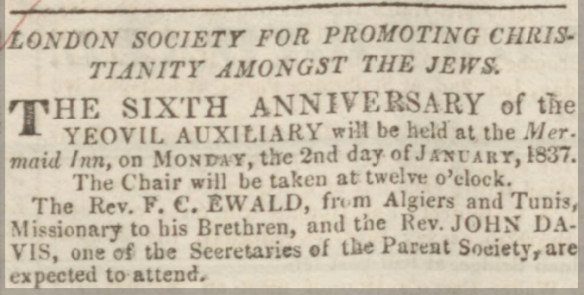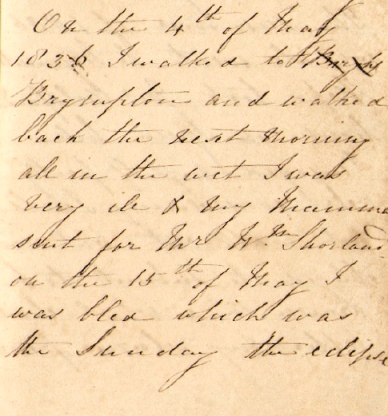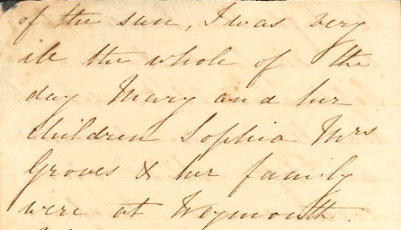From the journal of Miss Susanah Wellington (1819-1838) of Yeovil, Somersetshire.
Poor Wm Etheridge died on the 2nd of November 1836 his funeral sermon was preached by Mr Jukes at his chapel on Sunday Evening Novr 13th 1836.
January 1st 1837. Mr Ewald and Mr Davis preached two sermons in behalf of the Jews 30 pounds were collected at the doors. 2nd The Jews Meeting was held at the Mermaid Inn. When we returned we found quite a large party assembled in our dining room from Martock. Sophia Vining was with us.
. . . . . . . . . . . . . . . . . .
I found a notice in the Salisbury & Winchester Journal, Monday 14 November 1836:
Died, at Yeovil, on Wednesday, the 2nd inst., aged 18 years, after a few days’ illness, of effusion on the brain, William, fourth son of Mr. H. Etheridge, auctioneer. He was a very promising youth, and much and deservedly respected in the circle in which he moved.
William’s parents were Henry and Ann. Henry ETHERIDGE was a surveyer, auctioneer, real estate and insurance agent. William ETHERIDGE was born 24 June 1818 and christened in an Independent Chapel in Yeovil on 26 July 1819.
Mr John JUKES was a protestant non-conformist minister of the Independent Chapel in Yeovil, aligned with the Baptists. Mr JUKES served on the Yeovil Board of Health during the 1830s, along with Dr John PENKIVIL and chemist George WELLINGTON. Rev JUKES ran a school in Yeovil until 1835 when he resigned from teaching to concentrate on his ministry.

Rev John Jukes relinquished his school in Yeovil at the end of 1835. Sherbourne & Yeovil Mercury, 19 October 1835.
Susanah mentions that on the first day of 1837 there were two sermons preached and 30 pounds collected “on behalf of the Jews”. When I first read this journal entry I wondered if the sermons and donations were in aid of Jews that were persecuted and displaced from their homelands in Europe. Not so.
It appears from this advert in the Sherbourne & Yeovil Mercury, the Christian congregation were on a mission of conversion rather than of aid or charity. The meeting of the London Society for Promoting Christianity Amongst the Jews was held at the Mermaid Inn and Mr EWALD and Mr DAVIS were in attendance.

A newspaper notice for the meeting Susanah Wellington mentions in her journal. Sherborne & Yeovil Mercury, 26 December 1836.

This 1839 painting of High Street, Yeovil by Henry Burn (1807–1884) shows the Mermaid Inn archway and large overhanging sign on the left.
After the family returned home from their meeting, they found “quite a large party from Martock” in their dining room. Not much to go on here but they were most likely cousins – John WELLINGTON (1774-1845) and his wife Ann MARTIN (1774-1852) and their children. John WELLINGTON was a chemist and the elder brother of George WELLINGTON, chemist of Yeovil – Susanah’s father.
Sofia VINING was the youngest sister of James Tally VINING who was married to Mary Webb WELLINGTON. Sofia/Sophia VINING (1824-1848) was 12 years old, around the same age as Susanah’s sister Rosa WELLINGTON (1823-1889).
It has taken me quite a long time to research and identify all the players in this journal entry, but it is amazing the resources now available online at the British Newspaper Archives.
. . . . . . . . . . . . . . . . . .
Sources: Susanah Wellington’s Journal, BUCK family collection. You can read more about it here: susanah’s journal – somerset to sydney. British Newspaper Archives.
















![Weymouth print circa 1870 [www.dorsetshire.com]](https://branchesofourfamily.wordpress.com/wp-content/uploads/2013/09/weymouth-view_1870.jpg?w=467&h=322)
![Invalid wheelchairs from the 1800s. [image reblogged from www.biomedicalephemera.tumblr.com]](https://branchesofourfamily.wordpress.com/wp-content/uploads/2013/09/wheelchairs_1800s.jpg?w=584)


![Brympton d’Evercy manor house circa 1860 [Wikipedia – scan of a photo of c.1860 in an album put together by William/Emily Fane de Salis of Teffont].](https://branchesofourfamily.wordpress.com/wp-content/uploads/2013/09/brympton_entrance_front_1868.jpg?w=467&h=367)




